-
*Astrella.
User deleted
Miraculous Staircase of Saint Joseph, Loretto Chapel Santa Fe New Mexico
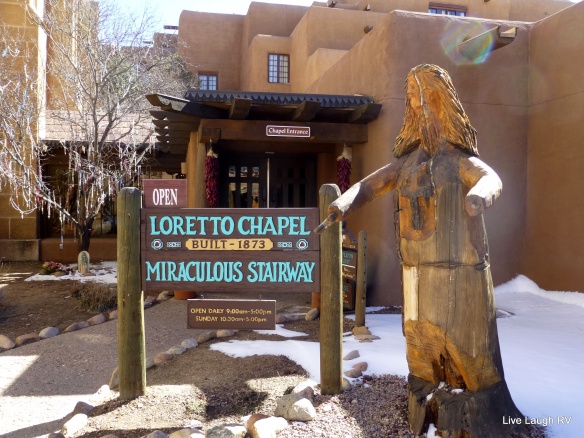
This is the miraculous staircase of Saint Joseph at Loretto Chapel in Santa Fé, New Mexico. U.S.A., which, after 134 years since it was built in 1878, still confounds architects, engineers, and master craftsmen in the physics of its construction and remains inexplicable in view of its baffling design considerations.
The unusual helix shaped spiral staircase has two complete 360° turns, stands 20 feet high up to the choir loft and has no newel (center pole) to support it as most circular stairways have. Its entire weight rests solely on its base and against the choir loft - a mystery that defies all laws of gravity, it should have crashed to the floor the moment anyone stepped on it, and yet it is still in use daily for over a hundred years.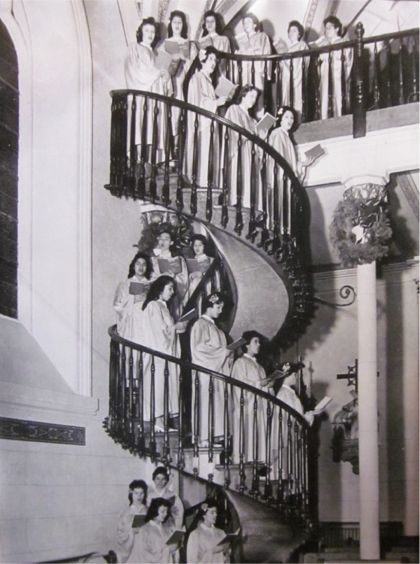
The risers of the 33 steps are all of the same height. Made of an apparently extinct wood species, it was constructed with only square wooden pegs without glue or nails. At the time it was built, the stairway had no banisters. These were added 10 years later in 1888 by Phillip A. Hesch at the Sisters' request.
There are four mysteries that surround the spiral staircase in the Loretto Chapel: the identity of its builder; the physics of its construction which defies all laws of gravity; origin of the type of wood used which does not exist in the entire region or anywhere near it; and the staircase which has 33 steps, the age of Jesus Christ.
Over the years, many have flocked to the Loretto Chapel to see the Miraculous Staircase. The case had been investigated and studied. The staircase has been the subject of many articles, and re-enacted in TV specials, and movies including "Unsolved Mysteries" and the 1998 television movie entitled "The Staircase", starring Barbara Hershey and William Petersen.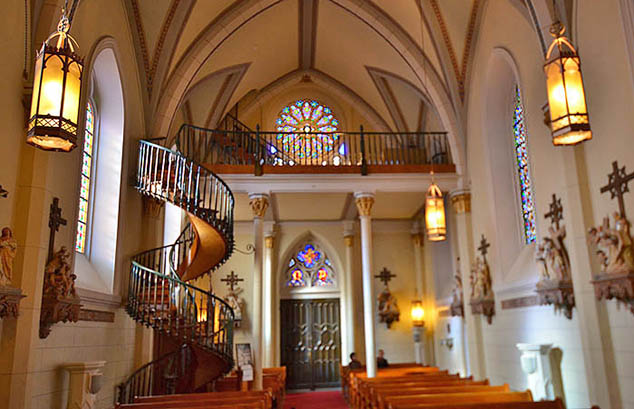
According to the accounts of Mother Magdalen, Mother Superior of the Sisters of Loretto, when the Chapel was completed in 1878, there was no way to access the choir loft twenty-two feet above. Local carpenters were summoned to address the problem, but all concluded that access to the loft would have to be via ladder as a staircase would interfere with the interior space of the small Chapel.
The Sisters of Loretto made a novena to Saint Joseph, the Patron Saint of Carpenters, and on the ninth and final day of prayer, a gray-haired man came to the convent on a donkey with a toolbox and approached Mother Magdalen. He asked if he might try to help the Sisters by building a stairway but he needed total privacy.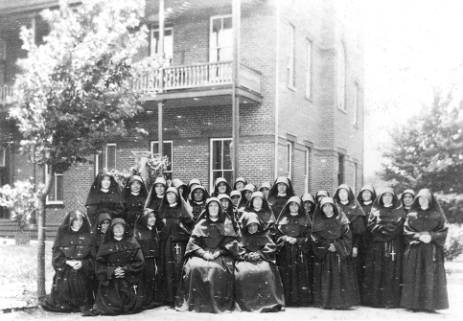
Mother gave her consent gladly, and he set to work and locked himself in the chapel for three months. The only tools he had were a saw, a hammer, a T-square, and a few tubs of water for soaking the wood to make it pliable.
When the staircase was completed, the carpenter disappeared without pay or thanks. The Loretto Sisters ran an advertisement in a local newspaper in search for the man but found no trace of him.
They offered a reward for the identity of the man, but it was never claimed. But Mother Magdalen and her community of Sisters and students knew that the stairway was Saint Joseph’s answer to their fervent prayers.
Many were convinced that the humble carpenter was none other than Saint Joseph himself, as his silent, prayerful labors were precisely the virtues one would expect of the foster-Father of Our Divine Lord.
One of the most baffling things about the stairway, however, is the perfection of the curves of the stringers. The wood is spliced along the sides of the stringers with nine splices on the outside and seven on the inside, each fitted with the greatest precision.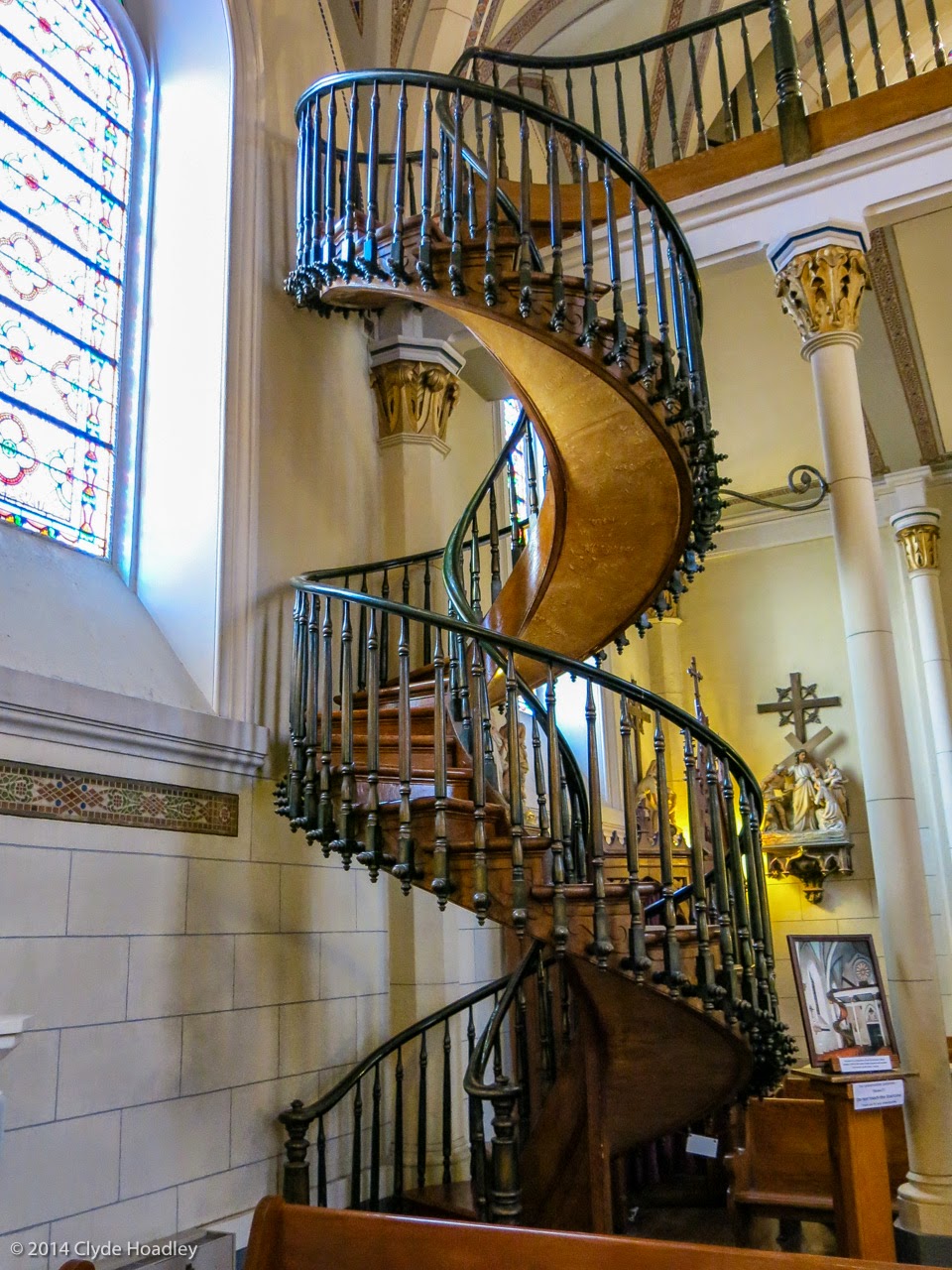
Each piece is perfectly curved. How this was done in the 1870's by a single man with only the most primitive tools is inexplicable to modern architects. Many experts have tried to identify the wood and surmise where it came from, but no one has ever been able to give a satisfactory answer to this mystery.
The treads were constantly walked on for over a hundred years since the stairway was built, but showed signs of wear only on the edges. The wood was identified as an "edge-grained fir of some sort", but others say it is a long-leaf yellow pine, but the hard-wearing wood definitely did not come from New Mexico.
Where the mysterious carpenter got this wood remains a mystery up to this day.
Brief History of the Chapel of Loretto
In 1610, the Spanish Catholic conquistadors and missionaries founded La Villa Real de la Santa Fe de San Francisco de Assisi, or Royal City of the Holy Faith of St. Francis of Assisi, known today as Santa Fé, the capital of New Mexico.
It was occupied by Indians, Mexicans, and Spanish and was under Spanish control until a war which placed this area under the rule of the New Republic of Mexico for 25 years. Later, as a result of the US victory in the Mexican war, this southwest area was ceded to the United States in 1848. At the end of the Old Santa Fe Trail stands the Loretto Chapel.
The history of the Loretto Chapel began when Bishop Jean Baptisite Lamy was appointed Vicar-Apostolic by the Church to the New Mexico Territory in 1850. Bishop Lamy, seeking to spread the Catholic faith and bring an educational system to this new territory, began a letter writing plea for priests, brothers and nuns to preach and teach.
In 1852, the Sisters of Loretto responded to Lamy’s pleas and sent seven sisters and opened the Academy of Our Lady of Light (Loretto) in 1853. The campus covered a square block with 10 buildings. Through tuition’s for the girls schooling, donations, and from the sisters own inheritances from their families, they built their school and chapel. Loretto Chapel, New Mexico, Santa Fe Images photgraphed by Jason St. Peter
Loretto Chapel, New Mexico, Santa Fe Images photgraphed by Jason St. Peter
Sisters Magdalen, Catherine, Hilaria, and Roberta made up the community. At the direction of Bishop Lamy, Sister Magdalen was appointed Superior of the Sisters.
It was then decided that the school needed a chapel. Property was purchased and work began on July 25, 1873, with Antoine Mouly as the architect. Mouly and his son, Projectus Mouly, were brought in by Bishop Lamy from Paris, France initially to build what is known today as the St. Francis Cathedral.
Bishop Lamy encouraged the sisters to utilize the Moulys to design and build their chapel. In the early 1800s, the older Mouley had been involved in the renovation of King Louis IX's Sainte Chapelle. It was the favorite chapel of Bishop Lamy from his early days in Paris, France.
Hence, the Loretto Chapel was patterned by Mouley after the Sainte Chapelle in the Gothic Revival style, complete with spires, buttresses, and stained glass windows imported from France. It is reported that the sisters pooled their own inheritances to raise the $30,000 required to build this beautiful Gothic chapel.
Source: http://infallible-catholic.blogspot.it/201...int-joseph.html.
Miraculous Staircase of Saint Joseph, Loretto Chapel Santa Fe New Mexico |


